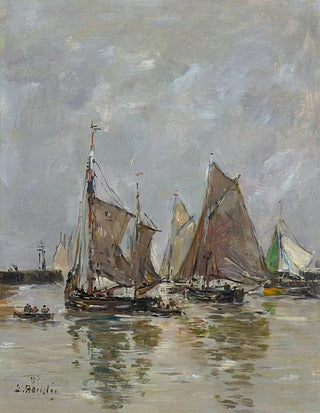Trouville Painting, the sardine fisherman's gear - Eugène Boudin | Art print


View from behind

Frame (optional)
Trouville Art print, the sardine fishermen's rigging - Eugène Boudin – Captivating introduction
The sea, with its wild beauty and infinite mysteries, has always been a source of inspiration for artists. Among them, Eugène Boudin, a pioneer of Impressionism, masterfully captured the essence of marine landscapes with a unique sensitivity. In his work "Trouville, the sardine fishermen's rigging," he transports us to the Normandy coast, where the movement of the waves blends with the hustle of the men. This painting, a true ode to maritime life, evokes an atmosphere that is both peaceful and lively, where the daily life of fishermen transforms into an almost poetic scene. Through this art print, viewers are invited to immerse themselves in a universe where time seems suspended, in vibrant harmony with nature.
Style and uniqueness of the work
The uniqueness of "Trouville, the sardine fishermen's rigging" lies in how Boudin plays with light and colors. The pastel shades, typical of his style, blend into a cloudy sky that hints at the sun's rays. The sails of the boats, white and radiant, contrast with the darker palette of the busy fishermen on the beach. This painting is not limited to depicting a simple fishing scene; it captures the soul of the Normandy coast, where salty air and the sound of waves create a lively atmosphere. The composition is carefully orchestrated, with each element finding its place to tell a story. The characters, though small in the landscape, seem animated by a palpable energy, bearing witness to their unbreakable connection with the sea.
The artist and his influence
Eugène Boudin, born in 1824, is often regarded as one of the pioneers of Impressionism. His work paved the way for artists such as Claude Monet and Pierre-Auguste Renoir, all of whom were influenced by his technique and vision. Boudin, as a keen observer of nature, always sought to capture the nuances of landscapes and skies in constant evolution. His innovative approach to plein air painting allowed him to seize light and atmosphere in a way

Matte finish

View from behind

Frame (optional)
Trouville Art print, the sardine fishermen's rigging - Eugène Boudin – Captivating introduction
The sea, with its wild beauty and infinite mysteries, has always been a source of inspiration for artists. Among them, Eugène Boudin, a pioneer of Impressionism, masterfully captured the essence of marine landscapes with a unique sensitivity. In his work "Trouville, the sardine fishermen's rigging," he transports us to the Normandy coast, where the movement of the waves blends with the hustle of the men. This painting, a true ode to maritime life, evokes an atmosphere that is both peaceful and lively, where the daily life of fishermen transforms into an almost poetic scene. Through this art print, viewers are invited to immerse themselves in a universe where time seems suspended, in vibrant harmony with nature.
Style and uniqueness of the work
The uniqueness of "Trouville, the sardine fishermen's rigging" lies in how Boudin plays with light and colors. The pastel shades, typical of his style, blend into a cloudy sky that hints at the sun's rays. The sails of the boats, white and radiant, contrast with the darker palette of the busy fishermen on the beach. This painting is not limited to depicting a simple fishing scene; it captures the soul of the Normandy coast, where salty air and the sound of waves create a lively atmosphere. The composition is carefully orchestrated, with each element finding its place to tell a story. The characters, though small in the landscape, seem animated by a palpable energy, bearing witness to their unbreakable connection with the sea.
The artist and his influence
Eugène Boudin, born in 1824, is often regarded as one of the pioneers of Impressionism. His work paved the way for artists such as Claude Monet and Pierre-Auguste Renoir, all of whom were influenced by his technique and vision. Boudin, as a keen observer of nature, always sought to capture the nuances of landscapes and skies in constant evolution. His innovative approach to plein air painting allowed him to seize light and atmosphere in a way
12,34 €






